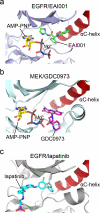Overcoming EGFR(T790M) and EGFR(C797S) resistance with mutant-selective allosteric inhibitors
- PMID: 27251290
- PMCID: PMC4929832
- DOI: 10.1038/nature17960
Overcoming EGFR(T790M) and EGFR(C797S) resistance with mutant-selective allosteric inhibitors
Abstract
The epidermal growth factor receptor (EGFR)-directed tyrosine kinase inhibitors (TKIs) gefitinib, erlotinib and afatinib are approved treatments for non-small cell lung cancers harbouring activating mutations in the EGFR kinase, but resistance arises rapidly, most frequently owing to the secondary T790M mutation within the ATP site of the receptor. Recently developed mutant-selective irreversible inhibitors are highly active against the T790M mutant, but their efficacy can be compromised by acquired mutation of C797, the cysteine residue with which they form a key covalent bond. All current EGFR TKIs target the ATP-site of the kinase, highlighting the need for therapeutic agents with alternative mechanisms of action. Here we describe the rational discovery of EAI045, an allosteric inhibitor that targets selected drug-resistant EGFR mutants but spares the wild-type receptor. The crystal structure shows that the compound binds an allosteric site created by the displacement of the regulatory C-helix in an inactive conformation of the kinase. The compound inhibits L858R/T790M-mutant EGFR with low-nanomolar potency in biochemical assays. However, as a single agent it is not effective in blocking EGFR-driven proliferation in cells owing to differential potency on the two subunits of the dimeric receptor, which interact in an asymmetric manner in the active state. We observe marked synergy of EAI045 with cetuximab, an antibody therapeutic that blocks EGFR dimerization, rendering the kinase uniformly susceptible to the allosteric agent. EAI045 in combination with cetuximab is effective in mouse models of lung cancer driven by EGFR(L858R/T790M) and by EGFR(L858R/T790M/C797S), a mutant that is resistant to all currently available EGFR TKIs. More generally, our findings illustrate the utility of purposefully targeting allosteric sites to obtain mutant-selective inhibitors.
Figures








Comment in
-
Allosterically targeting EGFR drug-resistance gatekeeper mutations.J Thorac Dis. 2017 Jul;9(7):1756-1758. doi: 10.21037/jtd.2017.06.43. J Thorac Dis. 2017. PMID: 28839955 Free PMC article. No abstract available.
References
-
- Mok TS, et al. Gefitinib or carboplatin-paclitaxel in pulmonary adenocarcinoma. N Engl J Med. 2009;361:947–957. - PubMed
Publication types
MeSH terms
Substances
Grants and funding
LinkOut - more resources
Full Text Sources
Other Literature Sources
Molecular Biology Databases
Research Materials
Miscellaneous

